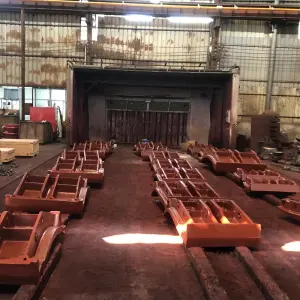Steel slag, as an industrial solid waste generated in the steelmaking process, its treatment and reuse are of vital importance. In the steel slag processing procedure, the crusher plays a crucial role in breaking down the hard steel slag to prepare for its subsequent recycling and application. The various parts in the crusher play a decisive role in the crushing effect of steel slag.
Crushing roller
In the steel slag double roll crusher, the crushing roller is the core component. This type of crusher is specially designed for steel slag processing. Its crushing rollers are made of wear-resistant materials. As steel slag is hard in texture and has certain corrosiveness, ordinary materials are difficult to withstand long-term impact and wear. During operation, the two crushing rollers rotate relatively, squeezing and crushing the steel slag that enters between them. The surface shape and tooth profile design of the crushing roller are also very crucial. An appropriate shape can increase the friction and biting force with the steel slag, making the steel slag easier to be crushed and improving the crushing efficiency and quality. For instance, the crushing rollers of some double-roller crushers have special patterns or serrated structures on their surfaces, which can effectively prevent steel slag from slipping on the roller surface and ensure the stable progress of the crushing process.
Hammerhead
Hammer crushers are relatively common in steel slag crushing, and the hammer heads are their main working parts. Due to the high hardness of steel slag, the hammer head needs to have high hardness, high strength and good wear resistance. Usually, hammer heads are cast from alloy materials, such as high manganese steel, etc. The service life of hammer heads made of such materials is several times that of ordinary manganese steel hammer heads. When the crusher is in operation, the motor drives the rotor to rotate at high speed, and the hammer heads also rotate at high speed, exerting a strong impact on the steel slag entering the crushing chamber. Under the impact of the hammer head, the steel slag is crushed and thrown towards the liner plate in the crushing chamber, where it is further impacted and crushed. The quality, shape and material of the hammer head have a significant impact on the crushing effect of steel slag. For instance, a heavier hammer head can generate a greater impact force at the same rotational speed and is more suitable for crushing large pieces of steel slag. And specific hammer head shapes, such as sharp front ends or grooves, can enhance the tearing and crushing effect on steel slag.
Backing plate
The liner of the crusher is installed on the inner wall of the crushing chamber, playing a protective role for the crusher body. During the process of steel slag crushing, the steel slag constantly collides and rubs against the liner, so the liner needs to have good wear resistance. Common liner materials include high manganese steel, high chromium cast iron, etc. When high manganese steel liners are impacted by steel slag, their surfaces will rapidly work harden, forming a hard surface layer, thereby enhancing their wear resistance. High-chromium cast iron liners feature high hardness and excellent resistance to abrasive wear. High-quality liners not only extend the service life of the crusher but also ensure the stability of the shape of the crushing cavity and maintain the efficient operation of the crusher. For instance, when the liner is severely worn, the size and shape of the crushing cavity will change, causing the movement trajectory of steel slag within the cavity to alter, which affects the crushing effect and may even lead to the malfunction of the crusher.
Screen (grating bar
Some crushers, such as hammer crushers, are equipped with screens or grates. Its function is to control the particle size of the steel slag discharged. After the steel slag undergoes multiple impacts and crushes in the crushing chamber, particles smaller than the gap size of the screen or grate bars will be discharged through the screen, becoming qualified crushed products. Steel slag larger than the gap size continues to be crushed inside the cavity. The material of the screen or grate bars should have certain strength and wear resistance to withstand the impact and friction of steel slag. Meanwhile, the gap size of the screen or grate bar can be adjusted according to the actual production needs, thereby producing steel slag products of different particle size specifications, meeting the requirements for steel slag particle size in different application fields such as construction aggregates and cement raw materials.
Transmission device
The transmission device is responsible for transmitting power to the working components of the crusher, such as the crushing rollers and rotors. In steel slag crushers, common transmission methods include belt drive, gear drive, etc. Take belt drive as an example. The motor drives the main shaft of the crusher to rotate through the belt, and then drives the working parts to rotate. The parts of the transmission device include pulleys, belts, transmission shafts, gears, etc. These parts need to have sufficient strength and stability to ensure the effective transmission of power and avoid phenomena such as slippage and jamming during the steel slag crushing process. For instance, the tension of the belt should be moderate. If it is too loose, it is prone to slipping, resulting in a decrease in power transmission efficiency. If it is too tight, it will increase the wear of the belt and pulley, and may even damage the transmission shaft and bearings. Gear transmission requires high precision and good meshing of gears to ensure smooth transmission, reduce vibration and noise, and improve the working efficiency and stability of the crusher.
Post time: Jul-15-2025

